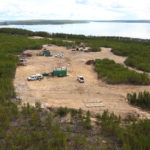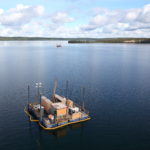Below is a post recently written by Ross McElroy and published on my Fission CEO Corner.
The PEA changed things for Fission. It answered a lot of questions in ways that we all understand… dollars and time. US$14.02/lb OPEX, 1.4 years payback (pre-tax) / 1.7 years payback (post-tax), 14 year mine life, pre-tax NPV of $1.81 Billion / post-tax NPV of $1.02 Billion (10% discount rate). In doing so, it added what every explorer needs before they will be taken seriously by the Majors and the big funds: Baseline economics and project validation. It’s why we keep reminding people that the Triple R is not only large and high-grade, it’s continuous and shallow enough for an open pit.
Triple R
The hallmark of Athabasca deposits is high-grade mineralization. But what is the point of having grades 10x to 15x higher than everywhere in the world if your mining costs are so high you can’t afford to mine it? Unless you have the ultra-high grades of McArthur River or Cigar Lake, that is the problem with deep deposits. But for Triple R, it’s incredibly shallow and that’s why it’s the envy of the industry.
Before joining the junior sector I spent many years working for the Majors and I can tell you that having viable economics puts us into an entirely new class as far as they are concerned. From here on, building on our economic base case is going to be a critical part of our drill programs.
With that in mind, we have a large, aggressive, fully-funded 2016 winter – spring drill program planned (est. 15,000m). Let’s review where we left off when the summer drilling ended and what we’re looking to do. First, the zone growth:
o The R600W zone (which is not yet part of the Triple R resource estimate or PEA) has seen a rapid growth rate. It won’t surprise you that this is a key area for us because, as it continues to grow, it will likely add not only pounds to the resource, but meaningful pounds that have the potential to enhance the PEA.
o The first high grades were discovered at the R1620E zone, located immediately to the east along trend of the Triple R deposit. This area has yet to see much drilling.
o Last but far from least, the Triple R has once again grown. Recently we drilled and received assays showing that a new high-grade area has opened up at the eastern end of the Triple R deposit. The all–important R780E remains open in many directions and its growth has the potential to improve the deposit’s size and thus economics even further.
Now the regional exploration. I know a lot of shareholders were delighted when we drilled anomalous radioactivity on Forest Lake towards the end of this summer. No high-grade uranium mineralization (yet) but there is smoke. Where there is smoke, we look for fire. Speaking of smoke, the regional results that have us really excited are the ones we got while drilling the Patterson Lake Corridor.
Let’s talk about the PLG-1B EM conductor. This basement conductor, shown by drilling to be a graphitic shear zone, is parallel to and located less than 500m north of the PLG3-B conductor, which hosts the Triple R deposit.
Three encouraging holes were drilled on this conductor approximately 470m north of the R600W zone. All three holes had very encouraging alteration and 2 holes registered anomalous radioactivity in the down-hole gamma survey, of almost 8,000 cps. For anyone unfamiliar with uranium exploration drilling, once the drill hole is completed, we lower a gamma probe into the borehole and record the radiometric result. We also measure the drill core with a similar (but handheld) instrument called a scintillometer.
Hole PLS15-419 showed a maximum of 7,965 cps at 153.5m and hole PLS15-425 showed a maximum of 4,168 cps at 100.8m. Those numbers are anomalous and highly encouraging. As we mentioned in the news release, the radioactivity was not identified in the recovered core, however, it’s not uncommon when drilling through clay-rich zones to have areas of core ‘washed out’ and thus lose some recovery.
With radiometric numbers like that, you can bet we will be following up on this area in particular when it comes to our future regional exploration drilling.
PLS’s uniqueness
PLS is unique, even among Athabasca Basin deposits and we have the 3rd party economic study conducted by the most respected name in the business (RPA) to prove it. Strengthening our economic base-case for the Triple R, bringing new resources into the mine plan and following up with our highest priority regional targets in the hunt for another mineralized trend. That, in a nutshell, is our focus going forward. Just today we had key members of our technical team conducting further reviews of our data as we plot the upcoming targets. As the weather starts to turn in the Athabasca Basin, site preparations will get underway and then the real fun starts. Stay tuned.
Ross McElroy, President, COO and Chief Geologist of Fission Uranium.
Readers should be aware that the PEA is preliminary in nature, that it includes inferred mineral resources that are considered too speculative geologically to have the economic considerations applied to them that would enable them to be categorized as mineral reserves, and there is no certainty that the preliminary economic assessment will be realized.
The PEA considers the PLS project as a stand-alone mine and mill operation, which includes development and extraction of the R00E and R780E zones (Triple R deposit) and that the PEA study is based on a number of qualifications and assumptions including the following (all values in C$ unless otherwise noted):
Physicals:
Three years of pre-production and 14 year mine life, processing nominally 1,000 tonnes per day (350,000 tonnes per year)
Total Tonnes Processed: 4.8 million tonnes at 1.00% U3O8 average grade; open pit mining of 1.56 million tonnes at 2.21% U3O8
• Underground mining of 3.25 million tonnes at 0.42% U3O8
• Process recovery of 95%, supported by metallurgical testwork
• Production of 100.8 million lbs U3O8; an average of 13 million lbs U3O8 per year for 6 years, followed by an average of 3 million lbs U3O8 per year for 8 years
Revenue:
• Long term uranium price of US$65 / lb U3O8
• Exchange rate of 0.85 US$ / C$1.00
• Gross revenue of $7.71 billion, less Saskatchewan gross revenue royalties of $556 million
• Less product transportation charges of $34 million
• Net revenue of $7.12 billion
Operating Costs
• Average OPEX of $16.50/lb (US$14.02/lb) U3O8 over the life of mine
• Unit Operating Costs of $346 per tonne processed. Combined Mining $154 per tonne processed
• Processing: $114 per tonne processed
• Surface and G&A: $78 per tonne processed
• Operating cash flow of $5.45 billion
Capital Costs
• Pre-Production capital costs of $1.1 billion
• Open pit mining $363 million (includes dyke, slurry wall, and overburden removal)
• Process plant $198 million
• Infrastructure $117 million
• Indirects $209 million
• Contingency $208 million
• Sustaining capital costs of $189 million (includes completion of overburden stripping, all underground mine capital costs, and tailings dam lifts)
• Reclamation and closure cost of $50 million
• Cash flow from operations of $4.12 billion
Dev Randhawa and Fission Uranium
Dev Randhawa is the founding Chairman and CEO of Fission Uranium. He has won numerous awards for his work in the industry, including Northern Miner Magazine ‘Mining Person of the Year 2013’ and as part of the Fission team, Mining Journal Excellence Award 2015 for Exploration.
Disclaimer
Forward-Looking Information: Some of the posted entries on the blog may contain forward-looking statements. Please find the full disclaimer here.








